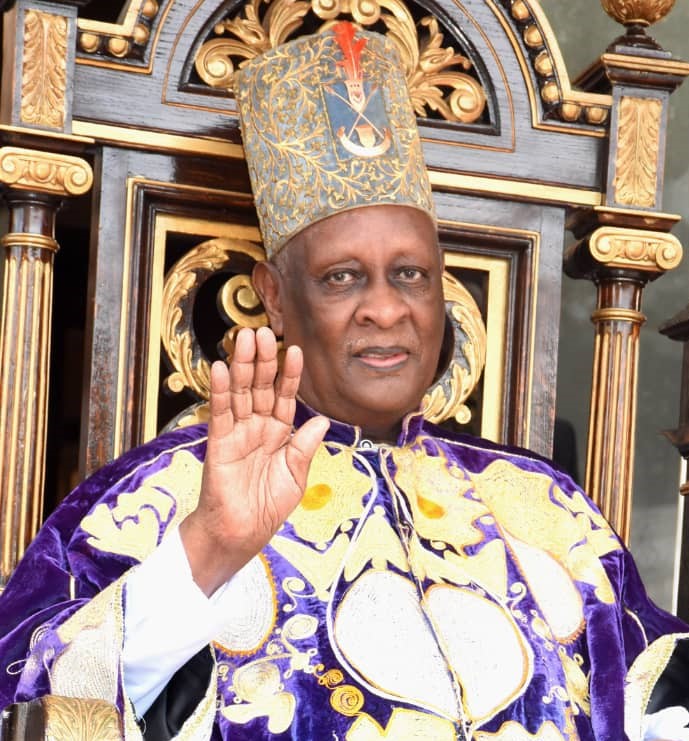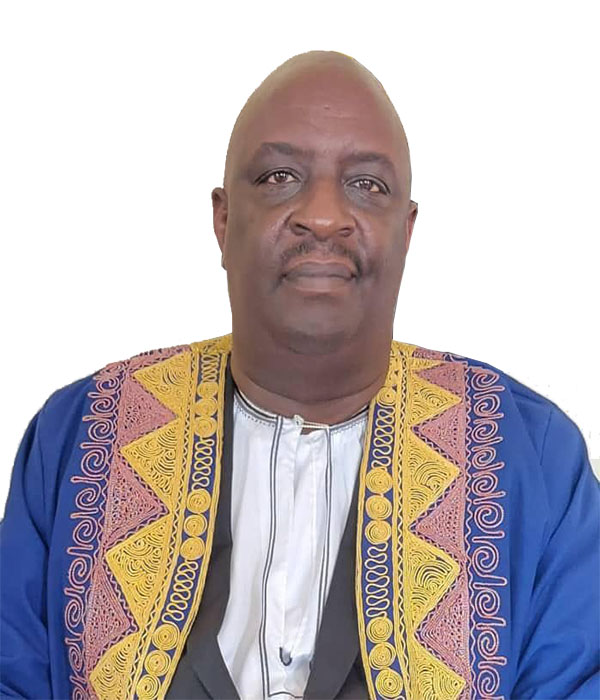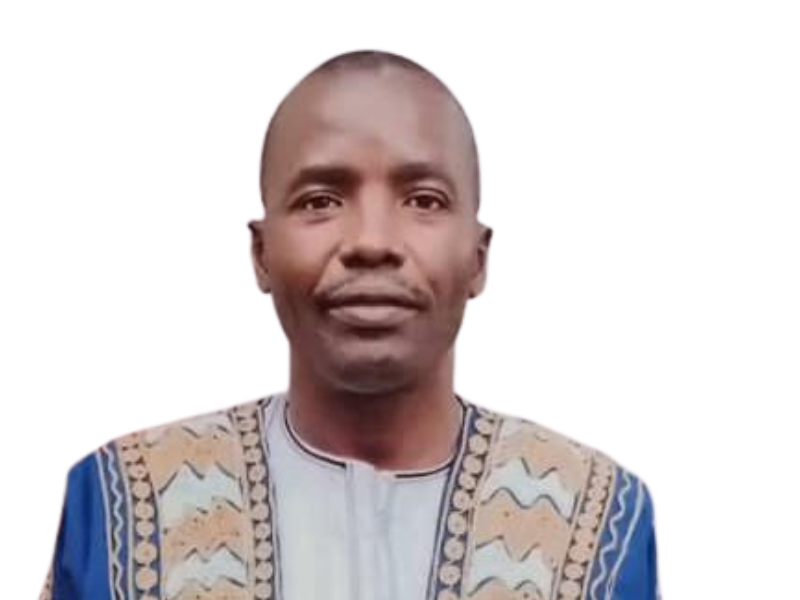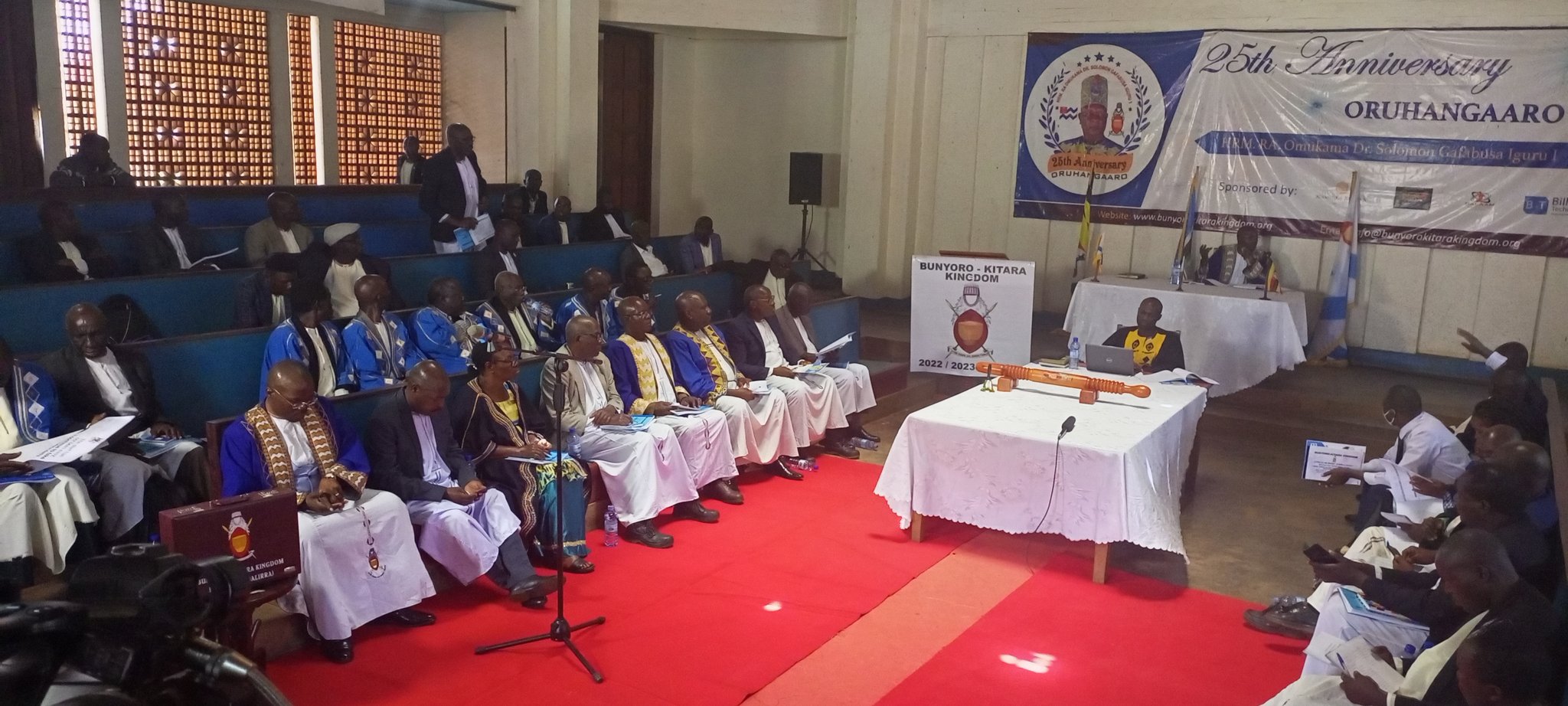
His Majesty Omukama Rukirabasaija Agutamba Dr. Solomon Gafabusa Iguru I
Omukama Rukirabasaija Agutamba Solomon Gafabusa Iguru I (born 1948) is the 27th Omukama of Bunyoro from 1994 to present.
The King’s Empaako (traditional alternative name used by family) is Amooti.
The Omukama (King) rose to the throne in 1994, after his father, Sir Winyi IV of Bunyoro, was annexed in 1967 by the Ugandan government.
Facts:
- Clan: Mubiito
- Totem: Engabi (bushbuck)
- Empaako (praise name): Amooti
- Father: Omukama Sir Tito Winyi Gafabusa IV (1822-1974)
- Mother: Gertrude Komweru (1920-2010)
- Siblings: 39 (17 boys and 22 girls)
- Grandfather: Omukama Yohana Cwa II Kabaleega (1854-1923)
- Official wife (Omugo): Margaret Karunga Adyeri
- Date of Birth: June 18, 1948
- June 11, 1994: Ascends to the throne
- Age of Ascention to the throne: 48
- Order of ascendance: 49th Omukama of Bunyoro-Kitara Kindom; 27th Omukama in the Babiito Dynasty
His Majesty, The Omukama (King) Rukirabasaija Agutamba Dr Solomon Gafabusa Iguru I is the reigning Omukama of Bunyoro-Kitara kingdom (1994-to-date). With his seat at Karuziika (palace), Hoima, Iguru is the is the 49th Omukama of Bunyoro-Kitara kingdom, but the 27th Omukama king under the Babiito dynasty – the third dynasty to have ruled Bunyoro-Kitara.
Iguru acceded to the throne upon the restoration of the Ugandan monarchies under Statute 8 of 1993 and is constitutionally recognised under Chapter 16, Section 246 of the Ugandan Constitution of 1995. Under Amendment (No. 2) Act 1995, Iguru is the titular head of the regional government and assembly of Bunyoro-Kitara and opens, addresses and closes sessions of Bunyoro’s Orukurato (Parliament).
Background: Iguru was born to Omukama Sir Tito Winyi IV of Bunyoro and Getrude Komweru Gafabusa Ateenyi on Friday, June 18, 1948. He is the grandson to the legendary Omukama Cwa II Kabaleega. In fact, he is the fourth successor to Kabaleega. Though Okaali is the tradition empaako (praise name) for a king, Omukama Iguru’s empaako is Amooti.
Physical appearance: At about 6ft tall, Iguru is a physically striking leader with a pleasant royal aura. His skin is of a light complexion with delectably large eyes, a broad but low forehead, high cheekbones, a large mouth, and with white teeth. He is usually immaculately clean and elegantly clad in his royal attire. Occasionally, you may find him in a suit or official dress – kanzu (tunic) and a jacket.
Education: His Majesty Rukirabasaija Iguru I studied at Kabaleega Secondary School. After completing his high school education, he joined the University of Manchester, UK where he studied Management.
Married life: Iguru is married with children. The Omugo (Queen) is Margaret Karunga Adyeri, who, in 2007, gave birth to Crown Prince David Rukidi Mpuuga. Mpuuga is followed by Omubiitokati (princess) Daisy Masamba Nkwanzi – named after a great Kalyota.
Note: Kalyota, or Batebete, but originally called Rubuga, is the official sister of a reigning king. Princess Masamba ga Winyi, who was the Kalyota of Omukama Chwa I Rumoomamahanga, was (and still is) the only known female monarch of Bunyoro-Kitara. She became the 11th Omukama of Bunyoro-Kitara, and she ruled the kingdom for four solid years.
It happened in the late 1600s (17th Century), when her ruling brother Cwa, the successor to their father Omukama Nyarwa Omuzaarakyaro, was killed during a punitive expedition against Rwanda — one of the chieftaincies which had, at the time, begun threatening to become independent.
Historians and scholars regard Masamba ga Winyi as the first female ruler in East and Central Africa. Her reign was characterised by peace and she is to-date a great inspiration to many a feminist. She was murdered by Chwa I’s son, Prince Kyebambe I Omuziikya, who became the 12th Mubiito king of Bunyoro-Kitara Kingdom. Her murder was reportedly plotted by conservative male chauvinists in the kingdom.
Ascension to the throne: Rukirabasaija Agutamba Solomon Gafabusa Iguru I ascended the throne on June 11, 1994. This followed 26 years of no monarchies after the Government of Uganda had
abolished kingdoms. At the time of abolition, Iguru’s father, Sir Tito Winyi Gafabusa IV, was the reigning king of Bunyoro. Indeed, in his secret will, Sir Winyi IV had named Solomon Gafabusa Iguru as his preferred successor – a secret only known to a few royals and confidantes.
Most Banyoro, especially the royal family, knew Prince John Rukidi was the heir. This issue ended up in the High Court of Uganda, which ruled in favour of Solomon Gafabusa Iguru. This was almost history repeating itself when Iguru’s great grandfather, Omukama Kamurasi Kyebambe (1852-1869), secretly named Kabaleega as his successor upon his death in 1869, yet Kabigumiire, who was Kabaleega’s elder brother, was the heir apparent.
After the court ruling, Iguru was specifically recognised as the rightful King of Bunyoro-Kitara by the Supreme Court of Uganda (Civil Appeal 18/94 and All Members of the Committee of Coronation of Prince Solomon Iguru of April 25, 1994). His status and position were formally recognised in the Uganda Gazette legal notice No. 303 of 2014.[2]
Coronation: After the death of Omukama Sir Tito Winyi Gafabusa in 1971, the kingdom remained in abeyance until 1994. Following the court ruling after the reinstatement of cultural institutions in Uganda, Iguru ascended the throne as the 27th Mubiito king. The colourful event was held at Karuziika (the palace) in Hoima on June 11, 1994.
Character and personality: Iguru is an amiable character. He is well read and educated, is well-grounded in the Bunyoro culture, and is widely travelled, hence he has international exposure. Iguru speaks impeccable Runyoro and his English is faultless. Those conversant with him describe Iguru
as soft spoken, highly intelligent and polished. Like his father and grandfather, Iguru is courageous, single-minded, and sympathetic to the common people. For those who believe in horoscopes, Iguru’s zodiac sign is Gemini, typical positive character traits, which include spontaneity, brazenness, action-orientation and openness.
The Royal Family: His Majesty Rukirabasaija Iguru I has been blessed with children. The princes are Richard Businge Kitehimbwa, Edward Budoli, David Rukidi Mpuuga. The princesses are Victoria Kabagabu (RIP), Doreen Kezia, Olive Kabasindi, Daphine Kabatalesa, Monica Bayoga, Ruth Kasemiire, Gertrude Komweru and Diasy Masamba Nkwanzi.
Reign: In his 26-year reign so far (2020), Iguru has promoted and developed the Kingdom. He is known to promote culture, education, health, agriculture, tourism, good governance, institutionalisation, peace, tolerance, patriotism and inclusiveness. Prominent among his development plans is his campaign against tobacco growing, fighting against HIV/AIDS and campaign for reproduction among the Banyoro.
He feels Banyoro are still few and marginalised, hence the need to produce more children in substantial numbers. Iguru has also promoted the establishing of such institutions as the Traditional
Leaders Association of Uganda and the global Association of the Representatives of Bunyoro-Kitara.
However, the injustices committed by the British colonialists to Bunyoro leaves a bitter taste in his mouth.
Although he seeks the support of the West to rebuild Bunyoro, he castigates them for the apparent atrocities committed to the people of Bunyoro. He has made several visits to European countries, but whenever he is addressing his subjects, he is critical of the white man. It is worth noting that, like other reigning monarchs, Iguru’s powers are limited to serving as a “cultural figure” or “traditional leader”. The law bars him – and other such leaders – from engaging in politics.
Status: In the present Constitution, kings are devoid of political power, are recognised as titular heads of regional governments. Among the documents that support this status are Section 8(a) of the Fifth Schedule of the Article 178 of the Constitution of the Republic of Uganda (2005 Amendment), as well as Section 6 of Chapter 16 Article 246 of the current Constitution.
However, in the 1994 ruling: Civil Appeal 18/94: Prince John D.C. Mpuuga Rukidi vs. Prince Solomon Iguru and Hon. Henry Kajura and All Members of the Committee of Coronation of Prince Solomon Iguru of April 25, 1994, Iguru was recognised as eligible to rightfully be enthroned as king (in this ruling, Omukama was translated specifically as King). Thus, it is that certain of the royal rights and prerogatives of the traditional kings of Bunyoro-Kitara have been reinstated and fully recognised by the present government of the Republic of Uganda.
Titles: Like his father, Iguru inherited Kabaleega’s nicknames such as “Ekitule Kinobere Abeemi” (one who is intolerant of rebels), “Ruhigwa”, “Rukolimbo nyantalibwa mugobe”, and “Rwota Mahanga” – just to mention a few – which testify to his indomitable, never-say-die character.
Iguru’s great titles include: Omukama of The Kingdom of Bunyoro-Kitara, Ruler of Hoima, Masindi, Kibaale, Buliisa, Kiryandongo, Kagadi and Kakumiro, The Grandson of Kabaleega, The Healer, The Orphan Protector ( Omukumanfuuzi), The Lion of Bunyoro (Entale ya Bunyoro), The Hero of Bunyoro, The Hero of Kabaleega (Mwijukuru wa Kabaleega), The Defender and Protector of Banyoro Culture, The Defender and Protector of Banyoro Oral Tradition, The Defender of Traditional African Religions, The Defender of the Religions.
He is also known as: The Sovereign Head and Grand Master of The Royal Order of Omujwara Kondo and The Royal Order of Engabu, The Sovereign Head, Grand Master and Protector of The Most Honourable Order of Omukama Chwa II Kabaleega, The Royal Patron of The Chivalrous and Religious Order of the Crown of Thorns, The Royal Patron of The Sovereign, Knightly and Noble Order of The Lion and Black Cross.
Awards: Iguru has won several awards. These include: Grandmaster, Royal Order of the Omujwaara Kondo; Grandmaster, Royal Order of the Engabu; Grandmaster, Most Honourable Order of Omukama Chwa II Kabaleega; Grand Cross, Royal Order of the Elephant of Godenu (Ghana); Grand Cordon, Royal and Hashemite Order of the Pearl (Sulu, Philippines); Grand Cross, Order of Saint Lazarus; Grand Cross, Order of the Queen of Sheba (Ethiopia); Kabaleega Star, Republic of Uganda; Honourary Cross, Royal and Merciful Society of Belgium; Patron, Protector and Granter of The Chivalrous and Religious Order of the Crown of Thorns; and, Patron, Protector and Granter of The Sovereign, Knightly and Noble Order of The Lion and Black Cross.
In addition, on July 13, 2010, the International Organisation – CCLP Worldwide (Special Consultative Status with UN ECOSOC) bestowed the highest honour of the organisation to Solomon Iguri for his services to the people of Bunyoro-Kitara. Since 2016 H.M. Solomon Gafabusa Iguru I is protector of the Heraldry Society of Africa. In effect, Iguru is the symbol of Bunyoro-Kitara, and an inspiration to his subjects.
In 2019, Iguru celebrated his “Oruhangaaro” – Silver Jubilee – as the Omukama of Bunyoro-Kitara Kingdom. Many Banyoro, among other people, wish him longevity and expect him to supersede his father who reigned for 43 years. Long live His Majesty The Omukama (King) Rukirabasaija Agutamba Dr Solomon Gafabusa Iguru I!
NB: The struggle for the throne between “Omwana w’Omukama” and “Omubiito w’Engoma”:
It’s is important to note the enthronement of Prince Solomon Iguru was delayed for more than six months – from November 27, 1993 to June 11, 1994 – because of the contestation for the throne with his brother, Prince John David Christian Mpuuga Rukidi.
True, Prince Mpuuga Rukidi had been the crown prince right from birth. Indeed, the day he was born -March 12, 1928 – there was proclamation in the Kingdom that he was heir and that the successor to the throne. Accordingly, March 12 became a public Holiday observed throughout the Kingdom. Thereafter he was treated as crown prince during his childhood, at school (King’s College Budo) and during public functions both within and outside the kingdom.
Indeed, Prince Mpuuga Rukidi was the Omukama’s first child and son with the Omugo (with whom he had eight children – three sons and five daughters). Later, in 1948, Prince Solomon Gafabusa was born. He was born of Gertrude Komweru Gafabusa Ateenyi (daughter of Edward Mudoli and Mudoli Bayoga). Gertrude Komweru was born in 1919 – died at 91 years of age on September 12, 2010 at 12:20pm). Her other children were Princess Ruth Kabajumba Bushara and Princess Juliet Kabacunga.
However, the Omukama Sir Tito Winyi later changed his mind in 1962 (as the Will below shows). On October 22, 1962, he made a Will in which he named his successor and heir. The Will which also listed all his 39 children (17 boys and 22 girls) was addressed (in a sealed envelope) to the then Chief Justice of Uganda, Sir Udo Udoma, who was to keep it under lock and key until the King’s death.



